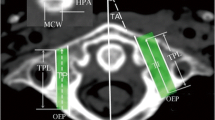Abstract
Purpose
To identify the ideal entry point for pediatric C2 pedicle screw and to obtain parameters of it for the indication of pediatric atlantoaxial fusion arthrodesis.
Methods
The pediatric cervical CT images were reconstructed into the 3D digital models and the C2 vertebrae were separated. The location of ideal entry point and screw placement related linear and angular parameters were assessed on the 3D digital models.
Results
A total of 214 pedicles from 107 C2 digital models were analyzed. The average entry point for C2 was 3.80 ± 2.78 mm medial to the lateral notch (LN) and 2.57 ± 1.70 mm superior to the LN. The average pedicle diameter (PD) was 6.02 ± 1.31 mm, and the average pedicle screw length (PSL) was 25.63 ± 3.46 mm. Statistical differences were found between different sex for PD and PSL (P < 0.05). As patient age increases, using the most lateral and inferior edge of the lateral mass as a reference marker, the entry point tends to move medial and cephalad, when using the LN as a reference marker, the entry point tends to move medial and slightly caudad. Univariate linear regression analysis suggested that these linear parameters were associated with age (P < 0.01).
Conclusion
In this study, we found that the measurement results of C2 pedicle screw varied based on sex, laterality, and ages for children younger than 18 years. The entry point of the screws facilitating ideal trajectory tends to change in a linear way as a function of age. This information helps the surgeon to establish the specific anatomy related to C2 pedicle screw placement to facilitate fixation in the pediatric patients.





Similar content being viewed by others
Data availability
All data including imaging used in this study were obtained from our Hospitals PACS system.
References
Harms J, Melcher RP (2001) Posterior C1–C2 fusion with polyaxial screw and rod fixation. Spine (Phila Pa 1976) 26:2467–2471
Abumi K, Ito M, Sudo H (2012) Reconstruction of the subaxial cervical spine using pedicle screw instrumentation. Spine (Phila Pa 1976) 37:E349-356. https://doi.org/10.1097/BRS.0b013e318239cf1f
Tukkapuram VR, Kuniyoshi A, Ito M (2019) A review of the historical evolution, biomechanical advantage, clinical applications, and safe insertion techniques of cervical pedicle screw fixation. Spine Surg Relat Res 3:126–135. https://doi.org/10.22603/ssrr.2018-0055
Huang DG, Hao DJ, He BR, Wu QN, Liu TJ, Wang XD, Guo H, Fang XY (2015) Posterior atlantoaxial fixation: a review of all techniques. Spine J Off J N Am Spine Soc 15:2271–2281. https://doi.org/10.1016/j.spinee.2015.07.008
Helenius I, Crawford H, Sponseller PD, Odent T, Bernstein RM, Stans AA, Hedequist D, Phillips JH (2015) Rigid fixation improves outcomes of spinal fusion for C1–C2 instability in children with skeletal dysplasias. J Bone Jt Surg Am 97:232–240. https://doi.org/10.2106/jbjs.n.00503
Resnick DK, Lapsiwala S, Trost GR (2002) Anatomic suitability of the C1–C2 complex for pedicle screw fixation. Spine 27:1494–1498. https://doi.org/10.1097/01.brs.0000018492.78081.97
Piatt JH Jr, Grissom LE (2011) Developmental anatomy of the atlas and axis in childhood by computed tomography. J Neurosurg Pediatr 8:235–243. https://doi.org/10.3171/2011.6.PEDS11187
Ebraheim N, Rollins JR, Xu RM, Jackson WT (1996) Anatomic consideration of C2 pedicle screw placement. Spine 21:691–694. https://doi.org/10.1097/00007632-199603150-00005
Xu RM, Nadaud MC, Ebraheim NA, Yeasting RA (1995) Morphology of the 2nd cervical vertebra and the posterior projection of the C2 pedicle axis. Spine 20:259–263. https://doi.org/10.1097/00007632-199502000-00001
Clifton W, Vlasak A, Damon A, Dove C, Pichelmann M (2019) Freehand C2 pedicle screw placement: surgical anatomy and operative technique. World Neurosurg 132:113. https://doi.org/10.1016/j.wneu.2019.08.198
Ferri-de-Barros F, Little DG, Bridge C, Cummine J, Cree AK (2010) Atlantoaxial and craniocervical arthrodesis in children: a tomographic study comparing suitability of C2 pedicles and C2 laminae for screw fixation. Spine (Phila Pa 1976) 35:291–293. https://doi.org/10.1097/BRS.0b013e3181afea7d
Geck MJ, Truumees E, Hawthorne D, Singh D, Stokes JK, Flynn A (2014) Feasibility of rigid upper cervical instrumentation in children: tomographic analysis of children aged 2–6. J Spinal Disord Tech 27:E110–E117. https://doi.org/10.1097/BSD.0b013e318291ce46
Fan D, Song R, Zhang M, Bai R, Li Y, Zhang Z, Wu H, Wang Y, Zhao L, Gao W, Dong H, Liao W, Liu Y, Zhang Y, Wang L, Wang W (2017) Guideline for C1 lateral mass and C2 pedicle screw choices in children younger than 6 years. Spine (Phila Pa 1976) 42:E949–E955. https://doi.org/10.1097/BRS.0000000000002016
Chin KR, Mills MV, Seale J, Cumming V (2014) Ideal starting point and trajectory for C2 pedicle screw placement: a 3D computed tomography analysis using perioperative measurements. Spine J Off J N Am Spine Soc 14:615–618. https://doi.org/10.1016/j.spinee.2013.06.077
Hirase T, Zhuge W, Phelps CI, Kushwaha VP, Marco RAW (2021) Determining C2 pedicle screw placement feasibility in the pediatric population: a computed tomographic safe zone analysis. J Pediatr Orthop 41:580–584. https://doi.org/10.1097/bpo.0000000000001938
Zhang Y-H, Zhou F-C, Zhang J, Song J, Shao J (2019) Efficacy and safety of atlantoaxial fluoroscopy-guided pedicle screw fixation in patients younger than 12 years. Spine 44:1412–1417. https://doi.org/10.1097/brs.0000000000003139
Funding
This Study was funded by Six-one Project (LGY2019037).
Author information
Authors and Affiliations
Corresponding author
Ethics declarations
Conflicts of interest
The authors have no financial or competing interests in relation to this work.
Additional information
Publisher's Note
Springer Nature remains neutral with regard to jurisdictional claims in published maps and institutional affiliations.
Supplementary Information
Below is the link to the electronic supplementary material.
Rights and permissions
Springer Nature or its licensor holds exclusive rights to this article under a publishing agreement with the author(s) or other rightsholder(s); author self-archiving of the accepted manuscript version of this article is solely governed by the terms of such publishing agreement and applicable law.
About this article
Cite this article
Fu, SY., Liu, H., Wang, ZR. et al. Ideal entry point and trajectory for C2 pedicle screw placement in children: a 3D computed tomography study. Eur Spine J 31, 3426–3432 (2022). https://doi.org/10.1007/s00586-022-07374-w
Received:
Revised:
Accepted:
Published:
Issue Date:
DOI: https://doi.org/10.1007/s00586-022-07374-w




